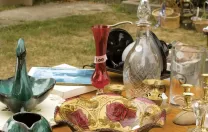Last year, Ronnie Mae Weiss and her husband, Richard Sobol, moved out of their longtime Lexington, Massachusetts, home, where a lovely stream ran through the backyard. Now in Cambridge, they live in a townhouse about half their old home’s size, lacking even a simple patio. In the process, they purged about 75 percent of their stuff.
“I walk both ways to work, instead of having all that time commuting in the car. My head is clearer,” says Weiss, director of human resources planning and programs development for the Faculty of Arts and Sciences. “It feels liberating to let go of all the material things that surrounded me. I have more time and I feel freer to really focus on the more emotionally and spiritually satisfying parts of life.”
Clearly, Weiss is not the first to advocate detaching oneself from possessions. “Plato was convinced that owning things was a vice to be avoided,” write Gail Steketee ’71 and Randy O. Frost in their book Compulsive Hoarding and the Meaning of Things. “He even argued that private ownership should be banned and that all property should be held in common.” Buddhists say that desire for things, including material goods, is a root cause of suffering. And in Walden, Henry David Thoreau, class of 1837, makes clear his view: “Most of the luxuries and many of the so-called comforts of life are not only not indispensable, but positive hindrances to the elevation of mankind.”
These days, in many parts of the world, the ability to buy and/or collect things is easier than ever. Daily goods are relatively cheap, available, and pushed on consumers through more advertising outlets than ever before. And given what much of that stuff is composed of, items from shoes to sofas are more readily disposed of than passed on. “What is it that makes us take on more than we need? Partly it is about materialism,” says Steketee, dean of Boston University’s School of Social Work. “We live in a society where marketing is part and parcel of our everyday lives; you can hardly go anywhere without seeing advertising. You get economic growth through buying and selling goods and services, but that means that everyone has to keep consuming. ‘More is better’ is just not serving us very well.”
In general, people accumulate stuff for three main reasons, notes Steketee: “The thing is beautiful, useful, or sentimental.”
A few years ago, Cambridge architect Brett Donham ’60, B.Arch. ’64, and his wife, Priscilla, A.A.E. ’75, moved out of the five-bedroom home in Cambridge they’d lived in since 1961. Their four children were grown, with homes of their own. “It is not sustainable or responsible for a couple to live in a home that size,” Brett Donham maintains. “We wanted to live lighter, suck up less energy; have less stuff to take care of, to clean, to repair and maintain.”
They moved into a 1,400-square-foot loft in a rehabbed brick warehouse building near the Watertown line. Even though their taste always tended toward clean lines in décor and well-designed objects, the move still meant getting rid of a houseful of things collected by adults and children across decades. “It takes awhile to untie the emotional bonds,” Donham says. “We realized that if we had not looked at something or used it in the last half-dozen years or so, that was a pretty good indicator that we were never going to need it.”
The hardest part was going through his 3,000 books. There were inscriptions in many that were important to Donham, or volumes that reminded him of good times with friends and family members, or trips. “For me, it’s particularly about remembering where you were when you read the book,” he says, “that context and a reminder of one’s emotional and intellectual maturity at the time. So you kind of go through the books and if you are by yourself, you process the memories—and if you are with someone else, you tell them, and they smile and throw the book in a pile to go out.”
About a hundred raggedy-edged paperbacks went straight into recycling bins, and Donham, through several rounds of purging, ultimately gave about 700 books to annual church sales. “It made me feel better to know they were being recycled, reused, reread,” he says. Then he took a few hundred up to their farmhouse in Maine.
In the examples above, living in smaller quarters with less stuff is also tied to a more urban lifestyle. Donham and Weiss both required their new homes to be near public transportation. Weiss has saved considerable time, and improved her health, by doing very little locally by car. (Donham has always walked to work.) “I walk fast, no strolling, to work every day, a little over a mile, each way,” she reports. “My husband has also joined a gym within walking distance and he is there almost every day.” With her extra time, Weiss has also volunteered to tutor through the Harvard Bridges to Learning Program, a two-hour-a-week commitment, and coaches recent college graduates in navigating their transitions to the working world. “Paring down and getting rid of clutter has aided an overall life process,” she says. “I’ve converted the time commuting, and cleaning and maintaining a home full of stuff, into the intangible things that are important to me.”
The previous house, says Weiss, “was filled with art—paintings and sculptures, mostly from our travels and Richard’s journeys all over the world creating his photography books. Magazines and books were piled up; every surface had multiple things on it—just stuff everywhere you looked.”
The couple invited each of their sons, now in their twenties, to take books and objects that were important to them. Then they gave a series of dinner parties for friends, who took something home at the end of the evening. “It was interesting art and people were happy to take it,” Weiss explains. “We did the same with the furniture. One friend took a table, another a bench.” Their son in Los Angeles took shipments of artwork; now, Weiss says, “It’s fun to go visit him because his place looks like our house—in miniature form.” They also donated many items to charity and put others out on the street for adoption. “Then,” she reports, “we sold our Lexington house in one day, and the next day bought the Cambridge townhouse. The guys from MiniMoves.com came and took what we had left and we brought anything that wouldn’t fit to a storage locker, which we finally emptied in May.”
Fast-forward to the new condo. “When you walk into the house, it’s clean and uncluttered,” Weiss reports. “The best artwork is out and [my husband’s] beautiful photos are up. Now you can really see them, because the place is not overpowered with everything else. It’s easier to keep clean and for me it’s a more relaxed environment. It’s nicer living without all of that stuff.”
The Donhams have also found that having a smaller house, with less stuff, simply opens the door to more time. “You are not spending your time taking care of your house,” he explains. “We’re finding we’re going to museums more, to festivals in Harvard Square, or to art galleries, or just taking walks.” They also more fully appreciate the space they do have, choosing what’s in it more carefully, and making the one dining table (they had two eating areas in the old house) a special place to be. “We are spending more time at dinner together, chatting away,” he reports.
The couple has traveled extensively in Italy, and appreciate how Europeans live. “We are very aware that you can live just as happily in smaller spaces,” he explains. “People love Italy and the cafés, the street life, and the sense of community. They don’t realize that in our American life we occupy four times the amount of residential space that the average Italian family does. People are outside together in Europe and in the cafés because they live in smaller spaces. It’s very ironic.”
Thanks to public transportation, he says, they are also traveling more lightly since the move. They can get almost anywhere without a car or fretting over parking, which is also liberating. “When we go abroad, we drag our suitcases out to Mount Auburn Street, in front of the cemetery, and take the short bus ride to Harvard Square, and the T to the airport,” he adds. “Then we spend the extra $60 we would have had to spend on a taxicab on a couple of nice meals in Italy.”
When it comes to possessions, are you a "packrat" or a minimalist? How do you manage your tendency to collect stuff? Tell us what you think in the comments section below.










